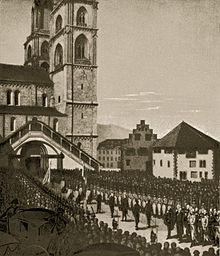
Since 1848 the Swiss Confederation has been a federal republic of relatively autonomous cantons, some of which have a history of federation that goes back more than 700 years, putting them among the world's oldest surviving republics.

The 26 cantons of Switzerland are the member states of the Swiss Confederation. The nucleus of the Swiss Confederacy in the form of the first three confederate allies used to be referred to as the Waldstätte. Two important periods in the development of the Old Swiss Confederacy are summarized by the terms Acht Orte and Dreizehn Orte.

The canton of Uri is one of the 26 cantons of Switzerland and a founding member of the Swiss Confederation. It is located in Central Switzerland. The canton's territory covers the valley of the Reuss between the St. Gotthard Pass and Lake Lucerne.

The Sonderbund War of November 1847 was a civil war in Switzerland, then still a relatively loose confederacy of cantons. It ensued after seven Catholic cantons formed the Sonderbund in 1845 to protect their interests against a centralization of power. The war concluded with the defeat of the Sonderbund. It resulted in the emergence of Switzerland as a federal state, concluding the period of political "restoration and regeneration" in Switzerland.

The rise of Switzerland as a federal state began on 12 September 1848, with the creation of a federal constitution in response to a 27-day civil war, the Sonderbundskrieg. The constitution, which was heavily influenced by the United States Constitution and the ideas of the French Revolution, was modified several times during the following decades and wholly replaced in 1999. The 1848 constitution represented the first time, other than when the short-lived Helvetic Republic had been imposed, that the Swiss had a central government instead of being simply a collection of autonomous cantons bound by treaties.

The Federal Assembly, also known as the Swiss parliament, is Switzerland's federal legislature. It meets in Bern in the Federal Palace.
Vorort is a German term that could be considered roughly equivalent to a suburb as that term is understood in Britain and North America. Vororte usually have their own business centre. They are the remainders of formerly separate neighbour towns, or have been founded as satellite towns. The term is contrasted with Vorstadt, which describes a more densely populated area grown at the outline of a city centre.

The Federal Constitution of the Swiss Confederation of 18 April 1999 is the third and current federal constitution of Switzerland. It establishes the Swiss Confederation as a federal republic of 26 cantons (states). The document contains a catalogue of individual and popular rights, delineates the responsibilities of the cantons and the Confederation and establishes the federal authorities of government.

The Act of Mediation was issued by Napoleon Bonaparte, First Consul of the French Republic on 19 February 1803 to abolish the Helvetic Republic, which had existed since the invasion of Switzerland by French troops in 1798, and replace it with the Swiss Confederation. After the withdrawal of French troops in July 1802, the Republic collapsed. The Act of Mediation was Napoleon's attempt at a compromise between the Ancien Régime and a republic. This intermediary stage of Swiss history lasted until the Restoration of 1815. The Act also destroyed the statehood of Tarasp and gave it to Graubunden.
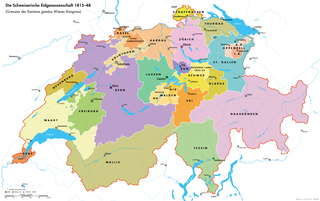
The periods of Restoration and Regeneration in Swiss history lasted from 1814 to 1847. "Restoration" is the period of 1814 to 1830, the restoration of the Ancien Régime (federalism), reverting the changes imposed by Napoleon Bonaparte on the centralist Helvetic Republic from 1798 and the partial reversion to the old system with the Act of Mediation of 1803. "Regeneration" is the period of 1830 to 1848, when in the wake of the July Revolution the "restored" Ancien Régime was countered by the liberal movement. In the Protestant cantons, the rural population enforced liberal cantonal constitutions, partly in armed marches on the cities. This resulted in a conservative backlash in the Catholic cantons in the 1830s, raising the conflict to the point of civil war by 1847.
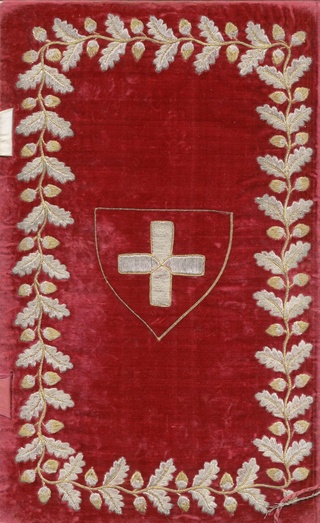
The Federal Treaty was the legal foundation for the new Swiss Confederacy of 1815. It came about after interventions by the great powers of the Sixth Coalition that defeated Napoleon.
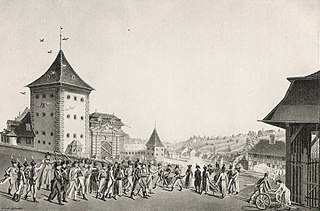
The Stecklikrieg of 1802 resulted in the collapse of the Helvetic Republic, the renewed French occupation of Switzerland and ultimately the Act of Mediation dictated by Napoleon on 19 February 1803. The conflict itself was between insurgents, mostly drawn from the rural population, and the official forces of the Helvetic Republic. The term Stäckli, or "wooden club," from which the conflict draws its name, refers to the improvised weaponry of the insurgents.
Events from 1848 in Switzerland.

Jean-Marc Samuel Isaac Mousson was a Swiss politician and civil servant. He was the first Chancellor of Switzerland from 1803 to 1830.
Josef Franz von Sales Johann Baptist Karl Nikolaus von Flüe Amrhyn, was a Swiss politician who served as the second Chancellor of Switzerland from 1831 to 1847.
Johann Ulrich Schiess was a Swiss politician who served as the third Chancellor of Switzerland.
George Bovet was a Swiss Politician from the Free Democratic Party of Switzerland (FDP).
Karl Huber was a Swiss politician and civil servant. He was a member of the Christian Democratic People's Party of Switzerland (CVP).
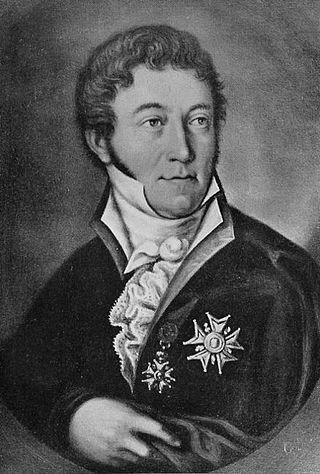
Vinzenz Rüttimann was a leading Lucerne politician during the first half of the nineteenth century. He served as president of the Swiss Federal Assembly (Tagsatzung) during 1820 and again during 1826.

Rageth Abys (1790–1861) was a Swiss politician, merchant, and soldier.

